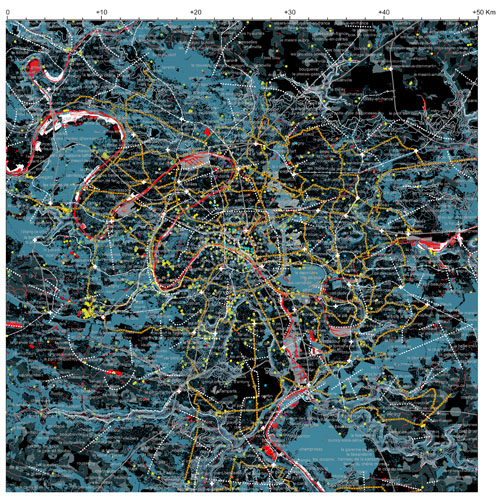Studio Associato Bernardo Secchi Paola ViganòArchitecture | Urbanism | Landscape |
| le Grand Paris : International Consultation of research and development for the future |
| client: | French Government, Public Institution for Business and Cultural Works |
| program: | territorial vision |
| date: | 2008-2009 |
| consultant: | IUAV (L.Fabian, E.Giannotti, P.Pellegrini), PVT France (F. Reutenauer, F.Prybyla, M.Lenz), Ingenieurburo Hausladen GMBH (G.Hausladen, J.Bauer, J.Comelia, C.Bonnet, R.Frohler), MIT and P-REX (A.Berger, Cleson and P-REX, case Brown), MOX (A.Quarteroni, P.Secchi, C.D'Angelo, F.Nobile, F.Della Rossa) EMU European Master in Urbanism, Fotography (T.Cos) |
| team: | |
| link: | ATELIER INTERNATIONAL DU GRAND PARIS |
The consultancy study on Great Paris Region is divided in three parts. The first part ''the porous city'': a knowledge strategy for XXI century -the after Kyoto age- metropolis makes clear our approach to figure out contemporary metropolis situations complexity and depict a possible future. We followed here this pattern: Paris, as others metropolis, will have to face, in the future, some important issues. This drives to the need of considering and build different 'scenarios'. In chapter two, we made a comparison with other metropolis through common criteria, specifying Paris diversity; not drawn only on long time fixed icons. Great Paris is neither only a main tourist venue, nor the mental images Paris inhabitants have of their city. A trial for a new approach study was our guideline. The second part ''the porous city illustrates three different 'scenarios' we consider fundamental for the XXI century -the after Kyoto - metropolis and its future. the scenario 1 took as a model a future of 100% durable energy situation; the second scenario envisages the creation of a new great wetlands system in the metropolitan area, aiming at a composed ecological and recreational system starting from the 'dross' biotic system; and, at last, the shift from a hierarchical vertical system to a horizontal isotropic mass transportation system. In the third part, finally, we will propose some strategic projects, interacting with the three scenarios. |
|

studio 08
<< bernardo secchi | paola viganò ![]()